Abstract
In Japanese agriculture, wheat harvest volume, cultivated area, and yield per 10a are important indicators. According to data for 2022, the national wheat harvest was 994kt, the cultivated area was 227kha, and the yield per 10a in Aichi Prefecture was 511kg. These figures suggest a trend towards stable wheat yields across the country, but limited growth in planted area. On the other hand, Aichi Prefecture has a high yield per 10 ares, showing differences in productivity between regions. This suggests that regional differences in climatic conditions and agricultural techniques may affect wheat yields. In general, wheat production is greatly influenced by regional differences and technological innovation, making efficient production management and technology transfer important.
Wheat yield (main data).
Japan’s wheat harvest has a long history, with data spanning from 1878 to 2022 showing changes over time. The peak was recorded in 1940 at 1.79 Mt, but it has been declining since then and is currently at only 55.4% of the peak. The reasons for this decline include changes in agricultural structure and market demand, as well as domestic and international competition. Wheat demand and production changed, especially as a result of postwar economic growth and food security policies. In recent years, while demand for wheat has shown a certain degree of stability due to diversification of diets and the expansion of international trade, domestic wheat production has continued to decline. In this context, agricultural policies and the introduction of technological innovations play an important role in improving the sustainability and competitiveness of wheat production.
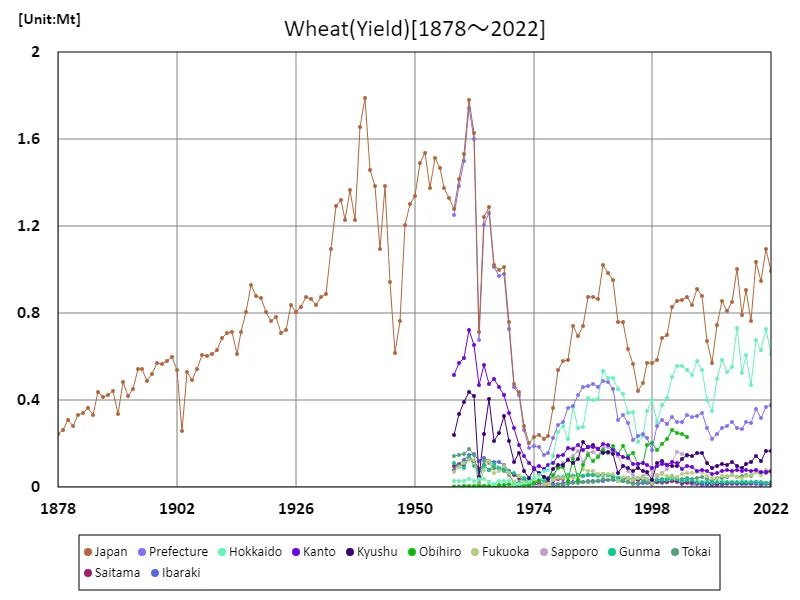

The maximum is 1.79Mt[1940] of Japan, and the current value is about 55.4%
Wheat harvest volume (by prefecture).
The latest prefecture-by-prefecture data for Japan’s wheat harvest for 2022 shows Hokkaido recorded the largest overall yield at 614kt. This data shows that Hokkaido is a major wheat producing region. Hokkaido has vast farmland and suitable climatic conditions, making it ideal for growing wheat. On the other hand, production volumes in other regions tend to be relatively low. This is due to differences in land use and climatic conditions from region to region, suggesting that there are regional differences in wheat production. And while demand for wheat has remained stable, domestic production may be sluggish overall. Under these circumstances, each region is required to improve agricultural techniques and promote efficiency in order to increase productivity.
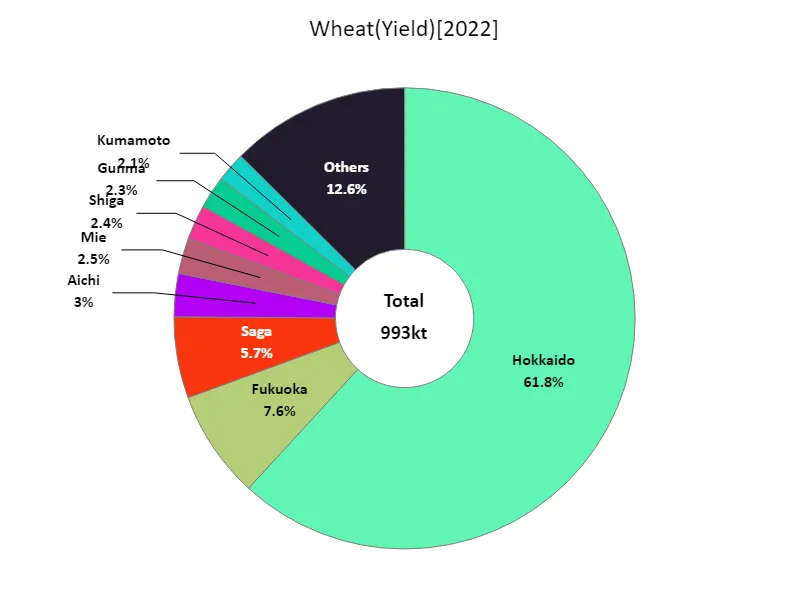

The maximum is 614kt of Hokkaido, the average is 21.1kt, and the total is 993kt
Area cultivated with wheat (main data).
Japan’s wheat cultivation area has a long history, and changes can be seen through data from 1878 to 2022. The peak was recorded in 1942 at 856 kha nationwide, but it has been declining since then, and currently stands at only 26.6% of the peak. The reasons for this decline include changes in agricultural structure and market demand, as well as domestic and international competition. Wheat demand and production changed, especially as a result of postwar economic growth and food security policies. In recent years, while demand for wheat has shown a certain degree of stability due to diversification of diets and the expansion of international trade, the area of land cultivated with domestic wheat has continued to decline. In this context, agricultural policies and the introduction of technological innovations play an important role in improving the sustainability and competitiveness of wheat production.
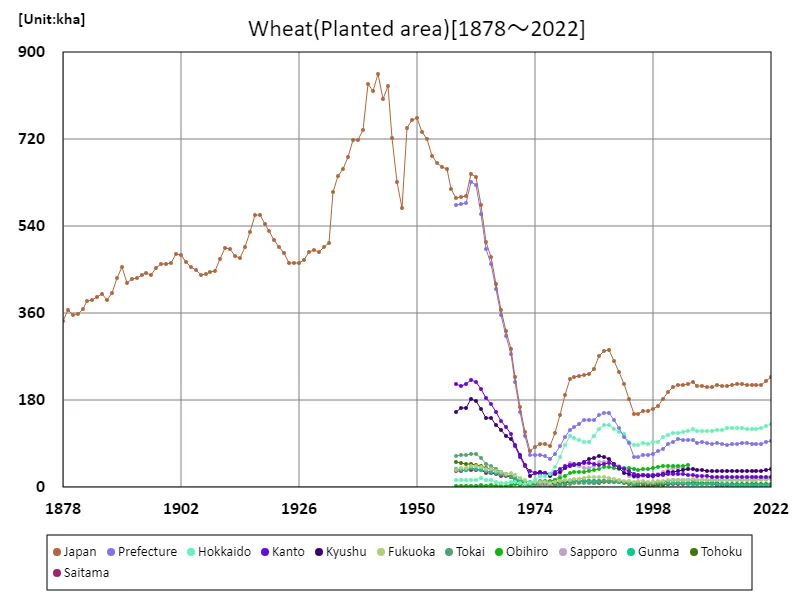

The maximum is 856kha[1942] of Japan, and the current value is about 26.6%
Wheat cultivation area (by prefecture).
According to the latest data for 2022, the largest wheat planted area in Japan is in Hokkaido, at 131kha. Hokkaido has the largest cultivated area, indicating that the region is the center of wheat production. Hokkaido has vast farmland and suitable climatic conditions, making it ideal for growing wheat. On the other hand, the area under cultivation tends to be relatively small in other regions. This is due to differences in land use and climatic conditions from region to region, suggesting that there are regional differences in wheat production. In addition, the area of wheat cultivated nationwide is on the rise, especially in Hokkaido, suggesting that the center of gravity of agriculture may be shifting between regions. Under these circumstances, each region needs to work to improve productivity and agricultural techniques to make wheat production more sustainable and competitive.
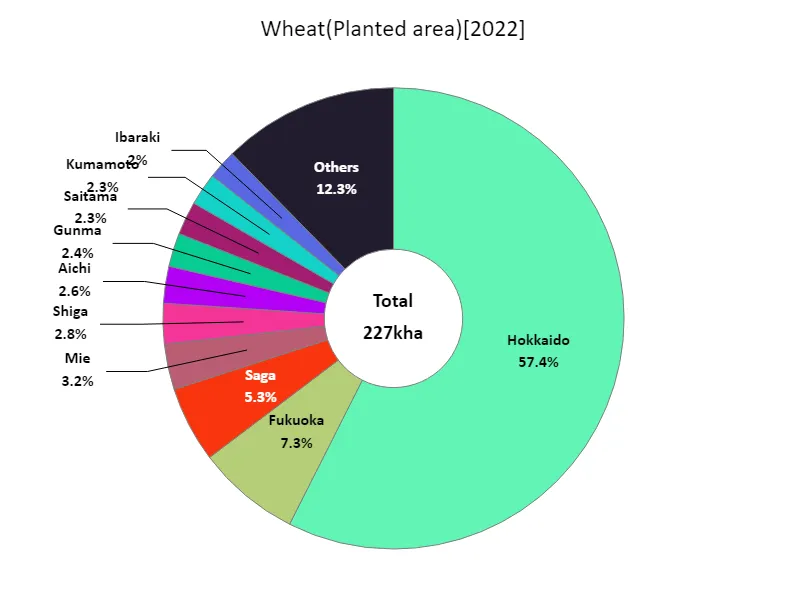

The maximum is 131kha of Hokkaido, the average is 4.84kha, and the total is 227kha
Wheat yield per 10a (by prefecture).
According to the latest data for 2022, the average wheat yield per 10a in Japan was 305kg, with the highest overall being in Aichi Prefecture at 511kg. This data shows that wheat yields per 10 ares vary between regions. Aichi prefecture has the highest yield, which indicates the high productivity of the region in wheat production. These regional differences are due to differences in climatic conditions and agricultural techniques in each region, and are an important factor in improving productivity in wheat cultivation. Furthermore, with the overall average yield being 305 kg, it can be said that wheat production in Japan is generally stable. However, this average does not take into account regional differences, which may affect overall wheat yields due to differences in productivity across regions. In general, wheat yields per 10 ares vary by region, and the introduction of regional agricultural policies and technological innovations will be key to improving yields.
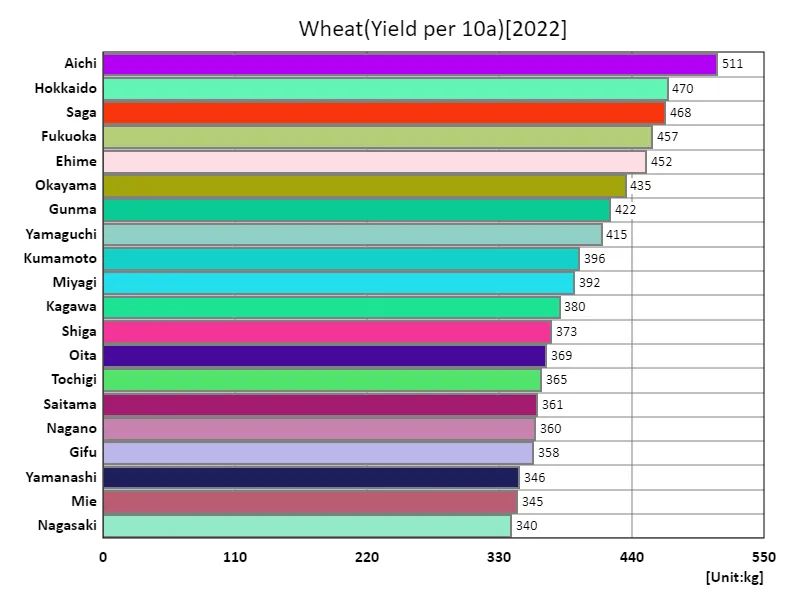

The maximum is 511kg of Aichi, the average is 305kg, and the total is 14.3t



Comments